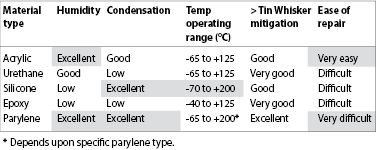

Electronics for military applications are expected to operate first time, every time and in some of the most varied and demanding environmental conditions known to man.
Military programmes often run over several decades and hardware will often be updated several times during the life of the programme.
Most aerospace electronics will be exposed to significant amounts of vibration, often extreme variations in operating temperature (depending on whether the electronics are situated in cabin or non-heated areas), as well as the opportunity to be exposed to cleaning chemicals and de-icing fluids etc. Commercial and military aerospace applications will typically have multi-decade programme lifetimes and the hardware will usually be upgraded several times during its service life.
The levels of required systems integration continue to grow, creating ever-increasing demands for greater packaging densities, reduced weight and increased reliability over a wider range of conditions, such as wider temperature ranges, increased thermal rates of change, greater ranges of vibration and longer storage in field conditions at the point of deployment.
It is worth considering the protection of the electronics from these environments as being composed of two parts: primary and secondary protection.
Primary protection
Aerospace or military electronics are typically placed inside a housing or box of some description. Wherever feasible, the box/housing in which the assembly is situated will form the primary environmental protection of the device; this can take the form of a hermetically sealed box or a housing that is designed to be completely dust and water resistant, or that channels such potentially harmful materials away from sensitive parts of the assembly, thus resulting in no damage to the hardware.
This is easy to say in theory, but much harder to achieve in reality, especially when the unit must be connected to another device (charging battery, communication/programming etc.) or requires cooling by airflow. Therefore, it is very common to use a conformal coating to provide a secondary level of protection to the electronic assembly and to provide a backup just in case the housing fails and is compromised.
Conformal coating as secondary protection
Given that the conformal coating is often providing secondary protection, it is useful to consider the main threats that must be mitigated against and other unique demands caused by the long service lifetimes of the assemblies, when selecting a suitable conformal coating material. Given that the housing should provide the main barrier properties, there are then five main criteria for the secondary protection: humidity/condensation, maximum operating temperature, operating temperature range, tin whisker mitigation and ease of repair.
Condensation
It is worth remembering that sealed units seal potential contaminants in as well as out. It is difficult to completely remove all traces of water from the housing and so there is a potential for humidity to be present inside the sealed housing. With changes in temperature and pressure, it is entirely feasible that the assembly will be subjected to condensed humidity as the surface of the circuit board passes through the ‘dew point’.
Maximum operating temperature
It is important that the conformal coating material does not soften significantly at the anticipated maximum operating temperature. This can cause the coating to ‘flow’ – resulting in exposed traces – and can trap particulate matter that may provide a conductive pathway, resulting in unexpected shorts.
Temperature operating range
In addition to the maximum operating temperature, it is important to ensure that the coating can survive transitions between the minimum and maximum operating temperature, at rates expected during service, without cracking. Cracks in the coating reduce the coating’s effectiveness as a barrier.
Tin whisker mitigation
With an ever increasing number of component leads being tin plated since the implementation of lead-free soldering, and the extremely long lifecycles of military and avionic assemblies, conformal coating has been widely employed as an effective mitigation strategy against tin whiskers.
Most generic coating types have been shown to provide mitigation against the risk of shorts due to conductive tin whisker filaments in numerous studies. In general, harder and tougher coatings tend to perform better in such evaluations, assuming the same degree of coating coverage of the lead-frame.
Repair or upgrade
During the upgrade or repair process, it is entirely likely that components will be replaced and ‘jumper wires’ will need to be run between different areas to provide hardware modifications. It is therefore desirable that the coating can be easily and cleanly removed from the required areas to facilitate these repairs, and that the coating has good adhesion to itself to ensure that an effective and permanent seal can be made to the repaired area. These issues can be avoided if it is easy to completely remove the entire conformal coating prior to repair.
Material selection
When considering these five factors in relation to the selection of an appropriate conformal coating material, Table 1 provides a summary of the generic material types and their respective relative performance capabilities. This table is deliberately generic, and there are a variety of hybrid materials that combine the best features of each class.

Acrylic materials
Acrylic materials generally provide a good balance of all the properties required of a secondary protection material. The main benefit of acrylic materials lies in the ease of repair and rework, since the entire coating can easily be removed by soaking in mild solvents.
Urethane and epoxy materials
Urethane and epoxy based materials are generally less effective as barriers with the exception of tin whiskers due to their greater hardness, and can be more prone to cracking in thermal excursions and generally require much more aggressive chemistries to remove them for rework purposes. Oil-modified or alkyd chemistries can outgas a variety of chemical compounds throughout their lifetime, especially at elevated temperatures, making these materials poorly suited for these applications.
Silicone materials
With the exception of moisture vapour, silicone materials generally provide good barrier properties and a wide operating temperature range. Silicone materials can often be difficult to remove effectively prior to rework, although mechanical abrasion can be effective. Room temperature vulcanising (RTV) silicone materials can tend to outgas a variety of by-products (some of which can be corrosive), so it is essential that the material is fully cured prior to being sealed in the unit.
Parylene
Parylene coating materials provide outstanding protective properties and due to the fact that they are vapour deposited in a vacuum, they give the best possible coverage. The primary drawbacks to parylene are the specialised deposition chambers required for application and the fact that masking must be 100% perfect. Parylene materials are difficult to inspect and rework. Parylene has poor inter-layer adhesion and is usually recoated with other material types after rework.
Summary
Conformal coatings are often used to augment the environmental protection afforded to the printed circuit boards by the housings or functional unit itself. Whilst there is no ‘correct’ choice, the factors of greatest importance to the reliability of the circuit board and the threat of exposure to these must form the basis of a rational choice. Of course, if the housing fails, and the conformal coating becomes the primary protective barrier, then that is an entirely different story.
| Tel: | +27 11 454 8053 |
| Email: | [email protected] |
| www: | www.vepac.co.za |
| Articles: | More information and articles about Vepac Electronics |

© Technews Publishing (Pty) Ltd | All Rights Reserved